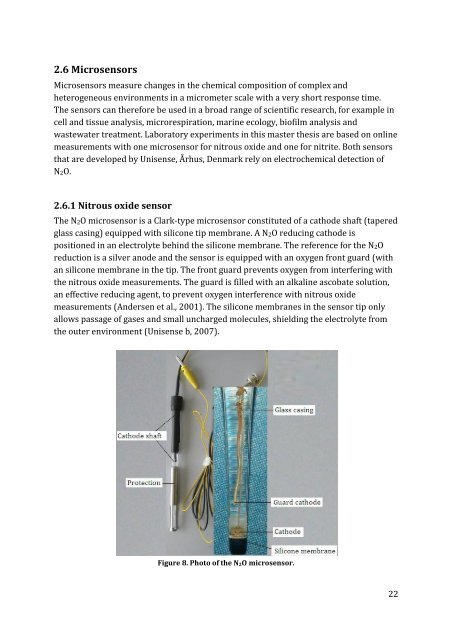N2O production in a single stage nitritation/anammox MBBR process
N2O production in a single stage nitritation/anammox MBBR process
N2O production in a single stage nitritation/anammox MBBR process
Create successful ePaper yourself
Turn your PDF publications into a flip-book with our unique Google optimized e-Paper software.
2.6 Microsensors<br />
Microsensors measure changes <strong>in</strong> the chemical composition of complex and<br />
heterogeneous environments <strong>in</strong> a micrometer scale with a very short response time.<br />
The sensors can therefore be used <strong>in</strong> a broad range of scientific research, for example <strong>in</strong><br />
cell and tissue analysis, microrespiration, mar<strong>in</strong>e ecology, biofilm analysis and<br />
wastewater treatment. Laboratory experiments <strong>in</strong> this master thesis are based on onl<strong>in</strong>e<br />
measurements with one microsensor for nitrous oxide and one for nitrite. Both sensors<br />
that are developed by Unisense, Århus, Denmark rely on electrochemical detection of<br />
<strong>N2O</strong>.<br />
2.6.1 Nitrous oxide sensor<br />
The <strong>N2O</strong> microsensor is a Clark-type microsensor constituted of a cathode shaft (tapered<br />
glass cas<strong>in</strong>g) equipped with silicone tip membrane. A <strong>N2O</strong> reduc<strong>in</strong>g cathode is<br />
positioned <strong>in</strong> an electrolyte beh<strong>in</strong>d the silicone membrane. The reference for the <strong>N2O</strong><br />
reduction is a silver anode and the sensor is equipped with an oxygen front guard (with<br />
an silicone membrane <strong>in</strong> the tip. The front guard prevents oxygen from <strong>in</strong>terfer<strong>in</strong>g with<br />
the nitrous oxide measurements. The guard is filled with an alkal<strong>in</strong>e ascobate solution,<br />
an effective reduc<strong>in</strong>g agent, to prevent oxygen <strong>in</strong>terference with nitrous oxide<br />
measurements (Andersen et al., 2001). The silicone membranes <strong>in</strong> the sensor tip only<br />
allows passage of gases and small uncharged molecules, shield<strong>in</strong>g the electrolyte from<br />
the outer environment (Unisense b, 2007).<br />
Figure 8. Photo of the N 2O microsensor.<br />
22















